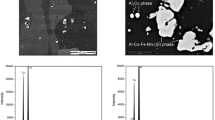Abstract
Corrosion fatigue crack propagation tests were performed on commercial 7075 alloys. Testing was done in a 3.5 pct sodium chloride solution under constant impressed potential and under reversed anodic-cathodic current conditions. Results indicated that a cathodic potential of -1.400 V vs SCE was sufficient to reduce corrosion fatigue crack growth rates to the level observed in dry argon. By alternately impressing anodic and cathodic currents, it was shown that anodic potentials enhance the crystallographic dependence of the fracture mode, resulting in brittle striations, while cathodic potentials result in ductile striations formed by shear. Modification of the alloy chemistry and lower impurity content resulted in a two-fold reduction in crack growth rates. Thermomechanical treatment of these alloys to refine the grain size proved detrimental. Adding an inhibitor to the sodium chloride solution was found to be the most effective means for reducing corrosion fatigue crack growth rates. A model for the environment-surface interaction is suggested.
Similar content being viewed by others
References
P. J. E. Forsyth, C. A. Stubbington, and D. Clark:J. Inst. Metals, 1961-62, vol. 90, p. 238.
C. A. Stubbington and P. J. E. Forsyth:J. Inst. Metals, 1961-62, vol. 90, p. 347.
C. A. Stubbington:Metallurgia, 1963, vol. 65, p. 109.
M. O. Speidel, M. J. Blackburn, T. R. Beck, and J. A. Feeney:Corrosion-Fatigue and Stress-Corrosion Crack Growth in High-Strength Alumunum Alloys, Mag- nesium Alloys and Titanium Alloys, Exposed to Aqueous Solutions, inProceed,of the Int. Conf. on Corrosion Fatigue, Storrs, Connecticut, June, 1971, to be published.
P. J. E. Forsyth and E. F. Sampson:Royal Aircraft Establishment, Technical Report No. 65158, 1965.
R. M. N. Pelloux:Fracture 1969, Proc. of the Second Int. Conf. on Fracture, Brighton, April, 1969, p. 731.
H. Bohni and H. H. Uhlig:J. Electrochem. Soc., 1969, vol. 116, p. 906.
G. T. Hahn, R. G. Hoagland, and A. R. Rosenfield: Tech. Rop., Battelle Co- lumbus, Contract AF 33615-70-C-1630, Project AR-016067/7021, August, 1971.
Author information
Authors and Affiliations
Rights and permissions
About this article
Cite this article
Stoltz, R.E., Pelloux, R.M. Mechanisms of corrosion fatigue crack propagation in Al-Zn-Mg alloys. Metall Trans 3, 2433–2441 (1972). https://doi.org/10.1007/BF02647046
Received:
Issue Date:
DOI: https://doi.org/10.1007/BF02647046




